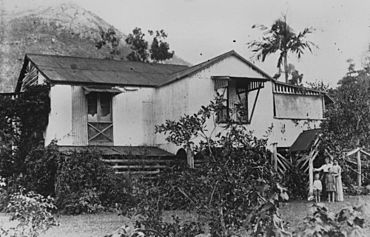Mount Jukes, Queensland facts for kids
Quick facts for kids Mount JukesQueensland |
|||||||||||||||
|---|---|---|---|---|---|---|---|---|---|---|---|---|---|---|---|

The house "Inglenook" with the mountain in the background, 1909
|
|||||||||||||||
| Population | 394 (2016 census) | ||||||||||||||
| • Density | 5.232/km2 (13.55/sq mi) | ||||||||||||||
| Postcode(s) | 4740 | ||||||||||||||
| Area | 75.3 km2 (29.1 sq mi) | ||||||||||||||
| Time zone | AEST (UTC+10:00) | ||||||||||||||
| LGA(s) | Mackay Region | ||||||||||||||
| State electorate(s) | Whitsunday | ||||||||||||||
| Federal Division(s) | Dawson | ||||||||||||||
|
|||||||||||||||
Mount Jukes is a mountain and surrounding coastal rural locality north of Mackay in the Mackay Region, Queensland, Australia. In the 2016 census, Mount Jukes had a population of 394 people.
Geography
The mountain is located in the south-west of the locality (20°59′52″S 148°56′57″E / 20.9978°S 148.9492°E) within Pioneer Peaks National Park and the Central Mackay Coast IBRA Region. It rises to 547 metres (1,795 ft) above sea level and is composed of igneous rock that has been weathered and eroded. The mountains originated from volcanic activity approximately 32 million years ago.
Mount Jukes has a species of shrubs growing in its trees called the Mount Blackwood holly, a species only found in Mount Blackwood area. The easiest route up the mountain is by gravel road that is locked.
History
Mount Jukes was named by George Elphinstone Dalrymple in 1862 after geologist Joseph Beete Jukes, who served as a naturalist on the explorations of HMS Fly from 1842 to 1846.


